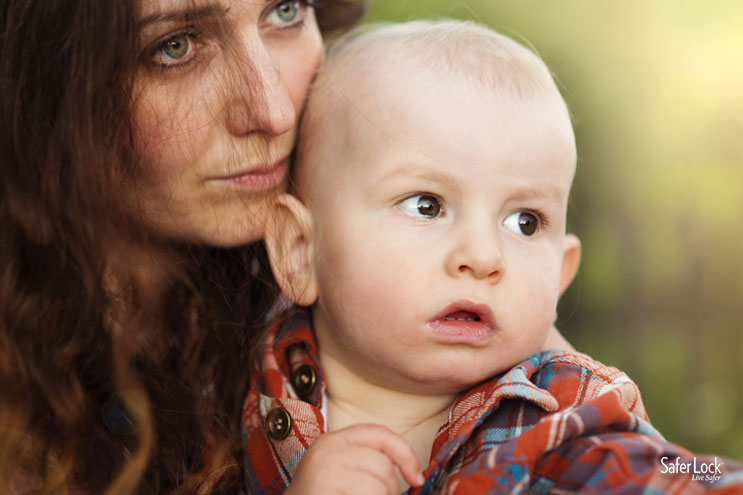The dangers of prescription drugs often focus on the potential for opioid abuse and addiction. After all, prescription opioid abuse has reached epidemic proportions in the US, and every day 44 people die from a prescription opioid overdose. But painkillers aren’t the only danger lurking in your medicine cabinet. Medications for cholesterol-lowering statin drugs, sleeping aids, and even those meant to prevent osteoporosis can be dangerous, as well.
A single cholesterol-lowering statin pill can be fatal to a small child who accidentally finds it in grandma’s purse, or on dad’s bedside table.
Prescription drugs can be dangerous, and even deadly, if children accidentally ingest them. Parents and grandparents need to be aware of the potentially severe and life threatening side effects of the following prescription drugs if they end up in the hands of a curious young child.
20 Medications You Need to Lock Up Now
- Abilify: A medication for bipolar disorder that may cause fatal or coma-inducing low blood sugar, or seizures and convulsions.
- Actonel: An osteoporosis medicine which may cause bone pain, high blood pressure, allergic reaction, toxic epidermal necrolysis (a rare, life-threatening skin condition that is usually caused by a reaction to drugs), liver damage, or a hole in the esophagus.
- Ambien: A sleep aid that may cause life threatening allergic reactions, hallucination, lung failure, and confusion.
- Boniva: An osteoporosis medicine which may cause life threatening allergic reaction, severe joint bone or muscle pain.
- Celebrex: An NSAID (non-steroidal anti-inflammatory drug) which may cause an increased risk of fatal heart attack or stroke, liver damage, a ruptured stomach wall, intestinal blood clots, bleeding of the stomach or intestines, hemorrhage within the skull, life threatening allergic reaction, or toxic epidermal necrolysis (a rare, life-threatening skin condition that is usually caused by a reaction to drugs).
- Chantex: An anti-smoking drug that may cause stroke, hallucinations, high blood pressure, chest pain, delusions, suicidal thoughts, or seizures.
- Crestor: Another cholesterol lowering statin drug with severe potential side effects including confusion, memory loss, liver damage, kidney damage, and diabetes.
- Evista: A medication to reduce the risk of breast cancer that may cause life threatening allergic reaction, death from stroke, coughing up blood, or trouble breathing.
- Fosamax: An osteoporosis medicine which may cause broken bones, jawbone deterioration, esophagus problems, low blood calcium, and extreme bone and joint pain.
- Humira: A TNF blocker prescribed for arthritis, Crohn’s disease, and psoriasis which may cause serious fatal infections, or fatal cancer.
- Lipitor: This cholesterol lowering statin drug has potentially severe side effects including dizziness, vomiting, liver damage, kidney damage, kidney failure, and could be fatal to a small child.
- Lunesta: A sleeping medication which may cause life threatening allergic reaction, suicidal thoughts, or high blood pressure.
- Lyrica: An anti-seizure medicine which may cause chest pain, seizures, heart failure, and life threatening angioedema (allergic reaction).
- Metformin: A diabetes medication which may cause seizures and death in non-diabetics.
- Prolia: A medication to treat postmenopausal osteoporosis that may lead to life threatening allergic reactions or heart valve infections.
- Rozerem: A sleeping medication which may cause life threatening allergic reaction, hallucinations, and trouble breathing.
- Sonata: A sleep aid which may cause anxiety, periods of not breathing, hallucinations, life threatening allergic reaction, and a “loss of one’s own sense of reality.”
- Tamoxifen: A medication prescribed to reduce the risk of breast cancer which may cause life-threatening case of blood clots, stroke or endometrial cancer, or birth defects.
- Topamax: An anti-seizure medicine also prescribed for migraines that may cause birth defects in pregnant women, and suicidal thoughts and actions.
- Yaz/Yasmin: A birth control which may cause migraine headaches, kidney disorders, and fatal blood clots.
This is not a complete list of all the side effects of these prescription drugs, but it is a sobering sample of the dangers of medications taken without a doctor’s supervision. Securing your prescription medications can help keep these prescription drugs out of the reach of young children who could be victims of a severe, or even potentially fatal, side effect.
How to Safely Secure Your Prescription Medications
Safely securing your prescription medications is easy. Choose a locking medicine storage option that best fits your needs:
Locking Medicine Boxes
If you have numerous prescription or over-the-counter medications in your home, a locking medicine storage box may be your best option. With a lock box, you can keep all of your medications safely in one location. If you like to organize your pills into a day-of-the-week container, you can also store this in your medicine box.
Locking Prescription Bottles
If you only have one or two prescription medications in your home, a combination locking bottle cap may be the right solution to secure your meds. This is also a great solution if you need to keep your prescription on you, or close by. Meds that are carried in a purse, left out on a counter, or stored on a bedside table should always be fitted with a secure, locking cap. A locking bottle cap is far more effective at keeping a young child out of a medicine bottle than a childproof or child resistant cap.
Young children are at risk any time a prescription medication is in their home. Whether it is dad’s cholesterol lowering statin drug, mom’s birth control pills, or grandma’s osteoarthritis medicine - one small pill could mean poisoning, hospitalization, or even worse to curious youngster.
Disclaimer: The medication side effects listed above do not constitute a complete list of potential side effects for the prescriptions mentioned. For a complete list of side effects for these medications, please talk to a pharmacist, medical professional, or contact the manufacturer. The contents of this blog are for informational purposes only, and do not constitute medical advice; the content is not intended to be a substitute for professional medical advice, diagnosis, or treatment. Always seek the advice of a physician or other qualified health provider with any questions you may have regarding a medical condition. Never disregard professional medical advice or delay in seeking it because of something you have read on this website.




